Sikorsky CH-53 Sea Stallion
The CH-53 Sea Stallion (Sikorsky S-65) is a family of heavy-lift transport helicopters designed and built by Sikorsky Aircraft. Originally developed for use by the United States Marine Corps, it is currently in service with Germany, Iran, Israel, and Mexico. The United States Air Force operated the HH-53 "Super Jolly Green Giant" during the late– and post–Vietnam-War era, updating most of them as the MH-53 Pave Low.
| CH-53 Sea Stallion | |
|---|---|
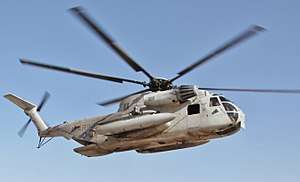 | |
| A CH-53D Sea Stallion with HMH-362, lands on FOB Edinburgh, Helmand province, Afghanistan | |
| Role | Heavy-lift cargo helicopter |
| National origin | United States |
| Manufacturer | Sikorsky Aircraft |
| First flight | YCH-53: 14 October 1964 |
| Introduction | 1966 |
| Retired | 2012 (U.S.)[1] |
| Status | In service |
| Primary users | United States Marine Corps (historical) German Army Israeli Air Force Mexican Air Force |
| Produced | 1964–1978 |
| Variants | HH-53 "Super Jolly Green Giant"/MH-53 Pave Low |
| Developed into | Sikorsky CH-53E Super Stallion |
The dimensionally-similar CH-53E Super Stallion is a heavier-lifting, improved version designated S-80E by Sikorsky. Its third engine makes it more powerful than the Sea Stallion, which it has replaced in the heavy-lift mission.
Development
Origins
In 1960, the United States Marine Corps began to seek a replacement for their HR2S piston-powered helicopters. On 27 January 1961, the Marine Corps began working with the U.S. Army, Navy, and Air Force on the "Tri-Service VTOL transport", which would eventually emerge as the Vought-Hiller-Ryan XC-142A tiltwing. The design became more elaborate and the program stretched out, causing the Marines to drop out when they decided they would not receive a working machine in a satisfactory timeframe. In the end, the XC-142A, although a very innovative and capable machine, never entered production.[2]
In March 1962, the United States Navy's Bureau of Naval Weapons, acting on behalf of the Marines, issued a request for a "Heavy Helicopter Experimental / HH(X)". The specifications dictated a load capability of 8,000 pounds (3,600 kg) with an operational radius of 100 nautical miles (190 km; 120 mi) at a speed of 150 knots (280 km/h; 170 mph). The HH(X) was to be used in the assault transport, aircraft recovery, personnel transport, and medical evacuation roles. In the assault transport role, it was to be mostly used to haul heavy equipment instead of troops.[2]
In response, Boeing Vertol offered a modified version of the CH-47 Chinook; Kaman Aircraft offered a development of the British Fairey Rotodyne compound helicopter; and Sikorsky offered what amounted to a scaled-up version of the S-61R, with twin General Electric T64 turboshaft engines and the dynamic system of the S-64/CH-54, to be designated the "S-65". Kaman's proposal quickly died when the British government dropped its backing of the Rotodyne program. Competition between Boeing Vertol and Sikorsky was intense, with the Chinook having an advantage because it was being acquired by the United States Army. Sikorsky threw everything into the contest and was awarded the contract in July 1962.[2]
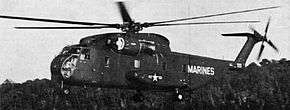
The Marines originally wanted to buy four prototypes but ran into funding problems. Sikorsky, determined to keep the deal, cut their estimate for development costs and said that the program could be done with two prototypes. The military bought the proposal, and in September 1962 Sikorsky was awarded a contract for a little under US$10 million for two "YCH-53A" prototypes, as well as a mockup and a ground-test airframe.[2]
The development program did not go entirely smoothly, due to a shortage of engineering resources plus various failures of subcontractors and the government, but these problems were gradually overcome. There was also the problem that U.S. Secretary of Defense Robert S. McNamara was pushing to maintain "commonality" between the armed services by using the Chinook, but the Marines managed to convince McNamara's staff that the Chinook could not meet their requirements without numerous expensive changes.[2]
The first YCH-53A performed its initial flight at the Sikorsky plant in Stratford, Connecticut, on 14 October 1964, about four months behind schedule. The Marines had already placed an initial production contract for 16 helicopters in September. Flight trials went more smoothly than expected, helping make up for the time lost in development. It received the military designation and name "CH-53A Sea Stallion".[2] Delivery of production CH-53s began in 1966.[3]
Further development
The CH-53A arrived in Vietnam in January 1967 and proved useful, eventually recovering even more downed aircraft than the CH-54. A total of 141 CH-53As were built, including the two prototypes.[2] The U.S. Navy acquired 15 CH-53As from the USMC in 1971 for airborne mine countermeasures (AMCM) activities. The helicopters had more powerful T64-GE-413 turboshafts installed and received the designation "RH-53A".[2]
The United States Air Force ordered the HH-53B in September 1966 and first flew on 15 March 1967. It added a refueling probe, drop fuel tanks and a rescue hoist; it also featured upgraded T64-GE-3 engines. The Air Force used the HH-53B for combat search and rescue (CSAR).[4] HH-53C was an improved CSAR variant with a smaller 450 US gallons (1,700 L) fuel tank in exchange for more armor and better communication systems. The CH-53C was similar except it lacked a refueling probe. It was used by the USAF for more general transport work.[5]

,
Heavy lifting in tropical climates demanded more power, so the Marines decided to acquire an improved variant, the "CH-53D", with uprated engines, originally the T64-GE-412 then later the T64-GE-413. The CH-53D also included an uprated transmission to go with the more powerful engines, and a revised interior to permit a load of 55 troops.[2]
The initial flight of the CH-53D was on 27 January 1969. The CH-53D served alongside the CH-53A through the rest of the Vietnam War. A VIP transport version designated, "VH-53D" with plush accommodations was used by the Marines for the US presidential flights.[2] The US Navy also acquired CH-53D based helicopters for mine sweeping. These were designated "RH-53D" and included mine sweeping gear such as a pair of 0.50 BMG (12.7 mm) Browning machine guns for detonating mines. The Navy received 30 RH-53Ds beginning in 1973. After the RH-53Ds were in service, the RH-53As were handed back to the Marines and restored to CH-53A configuration.[2]
During the 1980s, Israeli Air Force's CH-53 Yas'ur fleet was upgraded and improved by Israel Aircraft Industries, along with military high-tech firm Elbit Systems. The project – which ended only in 1997 – improved the CH-53 avionics, robustness and extended its life span by at least two decades.
In 1989, some of the CH-53As being retired by the Marines were passed on to the U.S. Air Force for training, with these helicopters redesignated "TH-53As". The TH-53As were stripped of most operational equipment and painted in USAF camouflage colors.[2]
Design
The Sea Stallion has a fuselage design similar to the Sikorsky S-61R/Jolly Green Giant series. It has a passenger door on the right side of the fuselage behind the cockpit and a power-operated rear loading ramp. The fuselage is watertight, though not intended for amphibious use, and is only intended to land on water in emergencies. The Stallion has mechanical flight controls which are backed by three independent hydraulic systems. Armor protects crew and vital systems.[2] The CH-53A carries a crew of four; pilot, copilot, crew chief, and an aerial observer, a load of 38 troops, 24 litters with medical attendants, an internal cargo load of 8,000 pounds (3,600 kg) or an external load of 13,000 pounds (5,900 kg) on the single-point sling hook. The CH-53A is equipped with a pair of 7.62×51mm NATO M60 machine guns that point out to each side of the fuselage.[2]
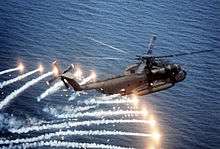
The CH-53A features a six-bladed main rotor and four-bladed tail rotor developed from those used on the S-64 Skycrane. To save space on board naval vessels, the tail boom and the rotors folded. Initially, the CH-53 was powered by twin General Electric T64-6 turboshaft engines providing 2,850 shaft horsepower (2,130 kW) each, each engine being located on the upper fuselage. Later engines included the T64-1 with 3,080 shp (2,300 kW) and the T64-16 with 3,485 shp (2,599 kW).[2] The HH-53B featured T64-3 engines producing 3,080 shp (2,300 kW).[5]
The CH-53D features uprated engines, initially T64-GE-412 with 3,695 shp (2,755 kW) then the T64-413 with 3,925 shp (2,927 kW) with an uprated transmission. Its interior added seats to allow for 55 troops. CH-53Ds are generally armed with twin .50 BMG (12.7 mm) M2/XM218 machine guns. In later years, CH-53Ds have been fitted with defensive countermeasures including an AN/ALE-39 chaff dispenser and an AN/ALQ-157 infrared countermeasure.[2]
Later production CH-53Ds featured a Blade Inspection Method (BIM) scheme to detect cracks in its metal rotors. BIM involved pressurizing the interior of the rotor blades with nitrogen. If a crack is present pressure is lost and a red indicator on the rotor blade tip was tripped. Later, the BIM system was connected to a cockpit display. BIM reduced the need to routinely swap rotor blades.[2]
Operational history
United States
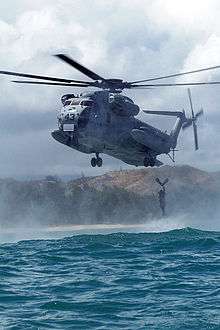
The CH-53/HH-53 has seen considerable use in warzones and served in various conflict during its service. It was first used in the Vietnam War, often recovering downed aircraft and evacuating personnel. The CH-53D served alongside the CH-53A through the latter portion of the US's presence in Vietnam; both types played a critical role at the end of the conflict, performing evacuations of personnel during Operation Frequent Wind.[2]
U.S. Air Force HH-53 Super Jolly Green Giants were the primary search-and-rescue helicopter in Southeast Asia between 1967 and 1975, inserted the Operation Ivory Coast rescue team into the North Vietnamese prison camp at Son Tay in 1970, and carried the Marines and Air Force Security Forces who attempted to rescue the crew of SS Mayagüez. Marine-flown Navy Sea Stallions were the rotary-wing element of Operation Eagle Claw, the attempted rescue of American hostages in Iran in 1980 that ended in disaster and embarrassment at "Desert One". Marine CH-53s were used in Grenada during Operation Urgent Fury.
The CH-53 was operated by the Air Force, United States Marine Corps and U.S. Navy in support of Operation Iraqi Freedom. It is also operated by all three services in support of Operation Enduring Freedom in Afghanistan.
On 17 September 2007, VMM-263 of the Marine Corps was deployed with ten MV-22B Ospreys, a tiltrotor aircraft.[6] V-22 Ospreys will replace the Marine Corps CH-46Es and CH-53Ds, but not their CH-53Es. The in-development CH-53K is planned to supplant the Navy and Marine Corps' CH-53Es.
HMH-463 replaced its CH-53Ds with CH-53Es in September 2011. HMH-363 and HMH-362 are to operate D-models until the squadrons are deactivated. Both units are to be reactivated as MV-22 and CH-53K squadrons respectively. Several CH-53D helicopters will be retained for the 3rd Marine Regiment for training.[7][8] HMH-362 retired the last CH-53Ds after its combat deployment in August 2012 and decommissioned in November 2012.[9]
Israel
In August 1968, an Israeli Air Force delegation went to the Sikorsky plant in Connecticut to choose the service's next assault helicopter. The delegation was looking for a helicopter with augmented payload carry capacity, highly maneuverable and robust, that could survive direct hits from different caliber projectiles. They examined Boeing's CH-47 Chinook, and Sikorsky's CH-53. Lessons that had been learned in the Six-Day War led the delegation to choose Sikorsky.

The CH-53 was bigger and stronger than the IAF's other helicopters, and represented a leap forward in capability to undertake rescue operations, transport missions and tactical troop landings. In September 1969, in the course of the War of Attrition, the first two CH-53s arrived at the port of Ashdod, and received their Hebrew name, Yas'ur (Petrel). They were sent into action in short order. On 6 August 1970 the first Yas'ur squadron was established. They are the main cargo helicopters of the IAF, carrying troops and heavy equipment.
In 1969, during the War of Attrition, IAF Yas'ur CH-53s landed in Egypt and conveyed a captured Soviet advanced radar system back to Israel for examination by Israeli scientists and engineers (see Operation Rooster 53).[10] In the 1973 Yom Kippur War, the Yas'urs moved artillery batteries around the fronts, evacuated wounded soldiers and rescued pilots from behind enemy lines. In one engagement, a Yas'ur was damaged by cannon fire from a MiG-21 but returned safely to base. Since 1973, Yas'urs have also been used by the IDF to land and extract Sayeret commandos on raids and patrols deep behind enemy lines in Lebanon Syria and the greater middle east.
During the 1980s, Israel Aircraft Industries, along with military high-tech firm Elbit Systems, upgraded and improved the IAF Yas'ur fleet. The project, ended in 1997, improved the CH-53's avionics and robustness and extended its life span by at least two decades.
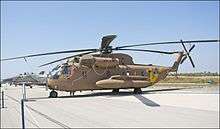
In 1989, Yas'urs were used to fight a huge blaze on Mount Carmel. They performed dozens of low flyovers into the smoke and flames, dumped 700 tons of water on the fire, and doused it.
During the 2006 Lebanon War, Hezbollah shot down an Israeli CH-53 Yas'ur with an anti-tank missile, killing five air crew members.[11][12] This was the only combat loss of an Israeli CH-53 during this war.[13]
On 16 August 2012, the Israeli Air Force grounded its fleet following a CH-53 having an in-flight problem that led to an emergency landing; initial reports state the problem was with the rotor blades.[14]
Iran

Six RH-53D Sea Stallions were delivered to the Imperial Iranian Navy (IIN) in the 1970s. Following the Iranian Revolution in 1979, the Sea Stallions continued in service with the renamed Islamic Republic of Iran Navy (IRIN).[3] These were supplemented by five U.S. Navy examples that were abandoned during Operation Eagle Claw in 1980.[15]
Germany
In 1966, the German military evaluated both the CH-53 and CH-47 Chinook as a replacement for the H-21 and H-34G helicopters with an initial requirement for 133.[16] The purchase of the CH-53 was approved in June 1968 but due to budget constraints only 110 were ordered.[16] Following the delivery in 1969 of two pre-production helicopters from Sikorsky the production aircraft were licence built by VFW-Fokker at Speyer in Germany.[16] The first German-built CH-53G Mittlerer Transporthubschrauber helicopter flew from Speyer on 11 October 1971 and was delivered to the Erprobungsstelle der Bundeswehr 61 flight test center at Manching on 1 December 1971.[16]
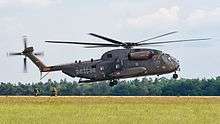
The German Army Aviation Corps received 110 type CH-53Gs, derivatives of the CH-53D, between 1971 and 1975. 108 helicopters were built in Germany by VFW-Fokker. The first flight by a German CH-53G was made in 1971, followed in March 1973 by the delivery of the first machines to Heeresfliegerregiment (HFlgRgt, Army Aviation Corps Regiment) 35 in Mendig, and shortly afterwards to the newly formed Army Aviation Corps Regiment 15 based at Rheine and Army Aviation Corps Regiment 25 based at Laupheim.
In order to meet ever more demanding specifications, over time the CH-53G received modifications from 1990 designed to improve its service life and operational capabilities. These involved three major upgrades: new missile warning and self-protection systems; provision for two external fuel tanks allowing range to be increased to 1800 km when carrying 36 armed soldiers or a 5.500-kg payload; and addition of a night vision goggles-compatible cockpit for night low-level flying capabilities. All CH-53Gs were upgraded by Eurocopter Germany by early 2001, resulting in updated GS/GE/GA variants. As a result of foreign military operations 20 CH-53G helicopters were converted to perform Combat Search and Rescue (CSAR) missions. Version CH-53GS is equipped with modernized IFR equipment, additional exterior fuel tanks, low-flight night vision cockpit and NVG, partial ballistic protection, engine dust collectors, missile counter measure and self-defence armament. Additionally the original engines were replaced by the more powerful T64-100 engines.
German Army Aviation Corps units have carried out a wide range of international missions under the auspices of NATO and the UN, providing transport for members of UNSCOM in Iraq, serving in Kosovo with KFOR, with IFOR in Bosnia and Herzegovina, and more recently with ISAF in Afghanistan. Due to the lower cargo capacities of the NH-90, service life extensions for at least a portion the CH-53 fleet are envisioned, bringing its useful life out to approximately 2030.
On 1 January 2013 all Army Aviation Corps CH-53Gs were transferred to the German Air Force and incorporated into Helicopter Wing 64.[17]
Austria
Two S-65C-2 or S-65Ö (actually CH-53D without refuelling probe) helicopters were delivered in 1970 to Austria to be operated mainly in rescue operations in the Alps. They were assigned to 1st Helicopter Wing, being Austrian Air Force the second foreign operator of the CH-53. Their equipment included same rescue hoist as the HH-53 and fittings for auxiliary fuel tanks and accommodation for 38 passengers. Although they performed well in high altitude operations their high operating costs eventually lead to selling them to Israel in 1981.[18]
Mexico
Fuerza Aérea Mexicana (FAM) bought 4 second hand Israeli CH-53D helicopters in 2004. They were upgraded to Yasur 2000 version before being delivered to Mexico in 2005. Due to poor budgets, only two were operated by 104th Air Squadron, being the other pair used as source of spares. Their initial missions were troop transport and commando insertion, but later main role was changed to rescue and disaster relief being relocated to BAM 8, Yucatán. By 2013 they had been retired.[19][20]
Civil use
In October 2004, Heavy Lift Helicopters of Apple Valley, California received the first of two CH-53D Sea Stallions from Davis-Monthan Air Force Base for conversion into firefighting aircraft. The modified helicopter is named "Fire Stallion".[21]
Variants
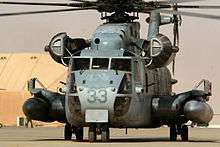


- YCH-53A
- Two prototypes with two 2,850 shp (2,130 kW) T64-GE-3 engines.
- CH-53A
- Initial production variant for the USMC. 139 built.
- RH-53A
- CH-53A re-engined with two 3,925 shp (2,927 kW) T64-GE-413 engines as Airborne Mine CounterMeasures (AMCM) variants for the U.S. Navy. 15 conversions.
- TH-53A
- Stripped CH-53As used for training by the United States Air Force.
- CH-53D
- CH-53A with an improved transmission, larger cabin for 55 troops and automatic rotor blade folding for the United States Marine Corps, 126 built.
- RH-53D
- United States Navy AMCM variant of the CH-53D, fitted with 0.50-inch caliber machine guns and provision for air refueling. 30 built for the USN. Six examples were also exported to Iran, before the Iranian Revolution in 1979.[3] This version can carry 11340 kg of cargo with cargo hook.[22]
- VH-53D
- Two CH-53Ds for USMC VIP transport
- VH-53F
- Six unbuilt VIP helicopters for the US Navy/Marine Corps.
- CH-53G
- German base version of the CH-53D for German Army Aviation Corps. The internal Sikorsky designation was S-65C-1.[23] A total of 112 were produced including 2 pre-production and 20 assembled by VFW-Fokker and 90 built by Speyer.[24] As of 2007, 89 German CH-53s were in service, with 80 planned to be in service in 2014. All German CH-53s are going to receive T64-100 engines (in 3 batches; first batch has already been installed, second batch is currently being installed and 3rd batch is planned with funding made available). All will receive IFR-capability.[25]
- CH-53GS
- Update of 20 CH-53Gs in the late 1990s, with additional missile counter measure, upgraded communication and navigation system and two external fuel tanks added.[24] They later received the first batch of T64-100 engines to operate in hot and high conditions that prevail in Afghanistan. MG3 and M3M machine guns were also fitted.[26] A CH-53GS/GE update has also been ordered to provide combat search-and-rescue (CSAR) capability to 26 helicopters.[27][28][29]
- CH-53GE
- A configuration based on CH-53GS combat search-and-rescue (CSAR) capabilities.[27] The upgrade configuration was formerly known as CH-53GSX. It further updates with modern electronics, two external fuel tanks, counter measures and dust filters for the engines. Upgrade was ordered to support Afghanistan deployment.[26]
- CH-53GA
- Update of further 40 CH-53Gs with new flight deck, new flight control system, autopilot, navigation and communication systems, FLIR, ECM and missile counter measures as well as provisions for additional internal fuel tanks. The CH-53GA helicopter successfully completed its first flight in February 2010.[30] The upgrade is to be completed in 2013.[31]
- S-65C-3 Yas'ur
- Export version for the Israel Air Force.[23] The Yas'ur 2000 version are helicopters upgraded and improved by the Israel Aircraft Industries to extend life span past 2000. The Yas'ur 2025 is a further upgraded version with new systems and new gearboxes.[32] Israel has 18 CH-53 2000s and 5 Yas'ur 2025s in service.[33]
- S-65Ö
- Export version for the Austrian Air Force. Internal Sikorsky designation was S-65C-2.[23]
- For other variants, see HH-53 "Super Jolly Green Giant"/MH-53 Pave Low and CH-53E Super Stallion.
Operators

Former operators
%2C_Austria_-_Air_Force_AN1828200.jpg)
Aircraft on display
United States
- On display
- 153304 – CH-53A on display at Flying Leatherneck Aviation Museum, MCAS Miramar, California.
- Fort Worth Aviation Museum, Fort Worth, Texas
Accidents and incidents
Due to the aircraft's large size and troop capacity, aerial accidents involving CH-53 helicopters have been some of the deadliest helicopter accidents.
- 1967-06-23, USMC CH-53A Bu. no #65-082 collided with a US Army UH-1B #63-8572 while taking off from Camp Lejeune, all 20 Marines on board were killed along with 2 occupants of the UH-1B.[39]
- 1968-01-08, USMC CH-53A #65-100 of HMH-463 crashed in the Hải Lăng Forest south of Đông Hà Combat Base, killing all 46 personnel on board[40]
- 1968-02-19, USMC CH-53A #65-055 crashed into Monkey Mountain killing all 13 personnel on board.[41]
- 1968-02-22, USMC CH-53A #65-060, was hit by antiaircraft fire and crashed at Khe Sanh Combat Base, killing 2 Marines.[42]
- 1968-05-01, USMC CH-53A #65-058 crashed into the sea off Quảng Trị Province killing 1 crewman.[43]
- 1968-07-28, USMC CH-53A #65-061 crashed south of Danang killing all 5 crewmen.[44]
- 1969-09-01, USMC CH-53A #65-059 crashed in Thừa Thiên Province killing all 5 crewmen[45]
- 1970-09-13, USMC CH-53D #65-181 was hit by antiaircraft fire and crashed with no fatalities.[46]
- 1970-10-26, USMC CH-53D #65-192 crashed on a test flight near Danang, killing 1 crewman.[47]
- 1970-10-30, USMC CH-53D #65-259 was hit by antiaircraft fire and crashed in Quảng Nam Province, killing 2 crewmen.[48]
- 1971-02-18, USAF CH-53C #65-227 of 21st Special Operations Squadron was hit by antiaircraft fire and crashed in Laos with no fatalities.[49]
- 1971-02-18, USMC CH-53D #65-189 crashed near Huế, killing all 9 personnel on board[50]
- 1971-03-01, USAF CH-53C #65-229 of 21st Special Operations Squadron was hit by antiaircraft fire and crashed near Long Tieng, killing 6 personnel.[51]
- 1972-07-11, USMC CH-53D #65-177 was hit by a surface to air missile and crashed near Quảng Trị, killing 3 crewmen and 45 South Vietnamese Marines.[52]
- 1975-01-24, USAF CH-53C #65-338 of 21st Special Operations Squadron suffered main rotor head failure and crashed near Nakhon Phanom Royal Thai Navy Base, killing all 4 personnel on board.[53]
- 1975-05-13, USAF CH-53C #65-231 of 21st Special Operations Squadron crashed west of Nakhon Phanom Royal Thai Air Force Base, killing 23 Air Force personnel[54]
- 1975-05-15, during the Mayaguez Incident, three CH-53 of the 21st Special Operations Squadron were shot down by the Khmer Rouge, resulting in the deaths of 10 Marines, 2 Navy Corpsmen and 2 Air Force crewmen.[55]
- 1975-09-26, USAF CH-53C #65-342 of the 601st Tactical Air Support Squadron crashed near Delbrück (Paderborn) Germany killing 16 personnel on board.
- 1977-05-10, a CH-53 crashed in Israel, resulting in the deaths of 54 people.
- 1977-10-21, a CH-53 crashed in Mindoro, Philippines during sling load operations due to a design flaw in the tail rotor drive; 31 US Marines serving in Operation Fortress Lightning were killed.[56]
- 1978-12-11, a CH-53G of the German Army Aviation Corps' Medium Transport Helicopter Regiment 25 crashed at Laupheim Air Base, Germany. During landing in poor visibility the tail rotor hit the ground. Of the four occupants, one was killed.[57]
- 1980-11-26, a CH-53G of the German Army Aviation Corps' Medium Transport Helicopter Regiment 15 crashed in a forest near Wippenkausen, North Rhine-Westphalia, Germany. All four occupants were killed.[58]
- 1983-04-27, a CH-53D crashed in the Atlantic off the coast of Virginia. The crash resulted in the drowning of Marine 1st Lt David A. Boyle. The suit brought by Boyle's father went to the Supreme Court.[59]
- 1984-03-24, a CH-53D crashed into a mountain in South Korea during a night troop operation, killing 29.[60]
- 1985-05-06, a CH-53D experienced a transmission failure and fell into Sea of Japan, killing 17.[60] It was returning to Marine Corps Air Station Futenma from MCAS Iwakuni, Yamaguchi Prefecture.
- 1988-12-29, an Israeli Yas'ur crashed during a border-stone laying mission, at the Israel-Egypt border. Investigation determined that high-frequency heterodyne vibration, induced by a late control column attitude correction during hover by the pilot (the sole fatality), caused a structural failure; the separation of the aircraft's tail and its immediate, rapid counter-rotation and subsequent crash. The three remaining occupants were injured. A footage of this crash can be viewed on-line. A system of dampers to prevent rapid correction and thus the heterodyne vibrations, has been installed since on the remaining Yas'ur helicopters.
- 1989-03-20, a Sea Stallion crashed while on maneuvers off mountainous east coast of South Korea, near P'ohang. 22 on board were killed. Sixteen other Marines, including one on the ground, were injured in the crash.[61]
- 1990-05-18, a Marine Corps CH-53D Sea Stallion en route to its base at the Marine Corps Air Station Tustin crashed in Imperial County, California, killing one crew member and injuring five others. In climbing flight, a pitch lock engaged in one main rotor blade causing a violent vibration that resulted in the tail rotor departing the aircraft at 2,200 ft AGL. Torque and rapid rotation contributed to the aircraft breaking apart further just aft of the main transmission. Auto-rotation resulted a bounce, roll over and fire. Aux tanks were attached. More than 200 servicemen had been killed in accidents involving the CH-53A, CH-53D, and CH-53E from 1969 to 1990.[62]
- 1994-03-14, a CH-53D landed tail-first and burst into flames on a military runway in Northern California. One Marine was killed and four Marines were injured.[63]
- 1997-02-04, two CH-53s collided in the "Helicopter Disaster" in Israel. A total of 73 people died in the accident.[64]
- 2002-12-21, a CH-53G of the German Army Aviation Corps' Medium Transport Helicopter Regiment 25 crashed near Kabul killing all seven occupants. An investigation following the accident concluded that the crash was caused by mechanical failure.[65]
- 2003-11-23, a MH-53M helicopter crashed on Nov. 23, 2003, near Bagram Air Base in Afghanistan. Five U.S. servicement were killed. "".
- 2004-08-13, a US Marine CH-53D from Marine Corps Air Station Futenma crashed into Okinawa International University on Okinawa, Japan. No serious damage or injuries resulted but the crash caused an international incident because of strained relations about the US use of Futenma. The crash was caused by a maintenance error.[66][67][68]
- 2008-11-28, a CH-53G Registratin 84+36 of the German Army Aviation Corps' Medium Helicopter Transport Regiment 25 had a hard landing during an exercise at an altitude of 6,900 feet (2,300 m) near Engelberg in the Swiss Alps, injuring one of the six occupants.[69] The dismantling and partial recovery of the helicopter wreckage was completed in June 2009 by helilifting 84+36 slung below her sister 84+32 down to the village of [Alpnach].[70]
- 2010-07-26, an Israeli CH-53 crashed during a training flight in the Carpathian mountains in Romania killing 6 Israeli soldiers and one Romanian.
- 2011-03-29, a Marine CH-53D from MCBH Kaneohe Bay crashed into the bay, killing 1 and injuring 3.[71]
- 2012-01-19, a Marine CH-53 crashed in southern Afghanistan. Six International Security Assistance Force (ISAF) troops, all U.S. Marines, were killed in the accident.[72]
Specifications (CH-53D)
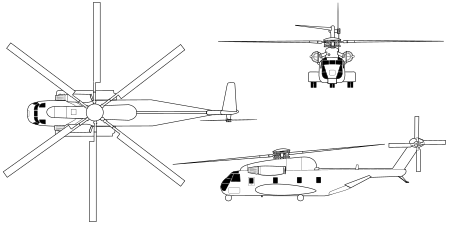
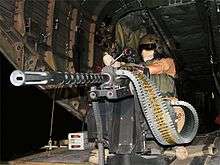
Data from Deagel.com,[73] U.S. Navy history,[74] International Directory,[3] US Navy Fact File[75][76]
General characteristics
- Crew: 2 pilots, 1 or more crew chiefs
- Capacity: 38 troops (55 in alternate configuration) or 24 stretchers
- Length: 88 ft 6 in (26.97 m)
- Rotor diameter: 72 ft 2.8 in (22.01 m)
- Height: 24 ft 11 in (7.6 m)
- Disc area: 4098.1 sq ft (380.48 m²)
- Airfoil: NACA 0011 MOD
- Empty weight: 23,628 lb (10,740 kg)
- Useful load: 8,000 lb (3,630 kg)
- Loaded weight: 33,500 lb (15,227 kg)
- Max. takeoff weight: 42,000 lb (19,100 kg)
- Width (stub wings): 28 ft 4 in (8.64 m)
- Width (fuselage): 15 ft 6 in (4.7 m)
- Rotor systems: 6 blades on main rotor
- Powerplant: 2 × General Electric T64-GE-413 turboshaft, 3,925 shp (2,927 kW) each
Performance
- Maximum speed: 170 knots (196 mph, 315 km/h)
- Cruise speed: 150 kt (173 mph, 278 km/h)
- Range: 540 nmi (1,000 km)
- Combat radius: 100 mi (160 km) 95 mi
- Ferry range: 886 nmi (1,640 km)
- Service ceiling: 16,750 ft (5,106 m)
- Rate of climb: 2,460 ft/min (12.5 m/s)
- Disc loading: 8.95 lb/sq ft ()
Armament
See also
Related development
- Sikorsky CH-53E Super Stallion
- Sikorsky CH-53K King Stallion
- Sikorsky CH-54 Tarhe
- Sikorsky HH-53 "Super Jolly Green Giant"/MH-53 Pave Low
- Sikorsky S-61R
Aircraft of comparable role, configuration and era
- Aérospatiale Super Frelon
- Boeing CH-47 Chinook
- Mil Mi-14
Related lists
References
Notes
- "End of an Era for an Icon of Marine Aviation". aero-news.net. 12 August 2012. Retrieved 15 April 2013.
- "S-65 Origins / US Marine CH-53A & CH-53D Sea Stallion". Airvectors.net, 1 Jan. 2016.
- Frawley, Gerard: The International Directory of Military Aircraft, page 148. Aerospace Publications Pty Ltd, 2002. ISBN 1-875671-55-2.
- Donald, David, ed. "Sikorsky S-65". The Complete Encyclopedia of World Aircraft. Barnes & Noble Books, 1997. ISBN 0-7607-0592-5.
- USAF HH-53B, HH-53C, & CH-53C, Vectorsite.net, 1 May 2006.
- Montgomery, Dave (19 September 2007). "1st squadron of V-22s quietly deployed to Iraq". Naval Air Systems Command. United States Navy. Retrieved 1 December 2008.
- Gidget Fuentes (26 September 2011). "Hawaii move marks the end for vintage CH-53s". Army Times. Archived from the original on 30 September 2011. Retrieved 26 September 2011.
- ""Ugly Angels" deactivate after 60 years of service". dvidshub.net. Retrieved 27 March 2018.
- Operation “Rooster”— Israel Captures Egyptian Radar In War of Attrition. Jewish Virtual Library. Retrieved 16 March 2008.
- "Security and Defense: Coordinating capabilities". Jerusalem Post. 12 August 2011. Retrieved 12 August 2011.
- "Israel studies CH-53 shoot-down". Flightglobal. 6 August 2006. Retrieved 12 August 2011.
- https://www.ynetnews.com/articles/0,7340,L-3290239,00.html
- Egozi, Arie. "Israeli air force grounds CH-53 fleet after emergency landing." Flight International, 17 August 2012.
- RH-53D Production List Retrieved 28 April 2012.
- Krueger, Alfred (November–December 1972). Air-Britain Digest. Air-Britain. 24 (6). Missing or empty
|title=(help) - Ray, Roland (14 December 2012), "Wir wollen Ihnen eine neue militärische Heimat bieten", Schwäbische Zeitung (in German), retrieved 6 January 2013
- https://www.sikorskyarchives.com/S-65H-53D%20SEA%20STALLION.php
- https://www.infodefensa.com/latam/2015/11/21/noticia-desmantelan-helicoptero-sedena-donado-estado-hidalgo.html
- https://archivo.eluniversal.com.mx/nacion/137780.html
- "heavylifthelicopters.com".
- John Pike. "RH-53D". globalsecurity.org.
- Sikorsky H-53 Sea Stallion, Retrieved 28 April 2012.
- Eden, Paul. "Sikorsky H-53", Encyclopedia of Modern Military Aircraft. Amber Books, 2004. ISBN 1-904687-84-9.
- http://www.dglr.de/news/lrifakten/archiv/LRIFakten2005-08.pdf
- Modernisierte Hubschrauber für Afghanistan-Einsatz, bundeswehr.de. (English translation.)
- "Germany Upgrading Its CH-53G Helicopters". Defense Industry Daily, 21 June 2009.
- Hoyle, Craig. "Eurocopter gets personnel recovery deal for German army CH-53s". Flight International, 23 June 2009.
- "Eurocopter signs contract to retrofit 26 CH53 Bundeswehr helicopters for personnel recovery missions ". Eurocopter, 18 June 2009.
- Hoyle, Craig. "German army CH-53GA prototype flies". Flight International, 11 February 2010.
- "German Heeresflieger order CH-53 upgrade" Archived 22 June 2008 at the Wayback Machine. Flug Revue, 25 February 2007.
- "Israel starts testing upgraded CH-53 assault helicopter". 5 January 2009.
- Israel acquires surplus CH-53 helicopters for spares – Flightglobal.com, 25 January 2013
- "World Air Forces 2014" (PDF). Flightglobal Insight. 2014. Retrieved 19 May 2014.
- "World's Air Forces - 1981". flightglobal.com. Retrieved 19 May 2014.
- "Heer und Luftwaffe tauschen Hubschrauber". Flugrevue. 14 December 2012. Retrieved 17 January 2013.
- Ray, Roland (11 January 2013), "Bundeswehr: 1200 Dienstposten bleiben in Laupheim", Schwäbische Zeitung (in German), retrieved 23 March 2013
- "RH-53D Sea Stallion". airvictorymuseum.com. Retrieved 26 July 2013.
- "ASN Wikibase Occurrence #74276". Aviation Safety Network. Retrieved 4 October 2017.
- "ASN Wikibase Occurrence #76027". Aviation Safety Network. Retrieved 4 October 2017.
- "ASN Wikibase Occurrence #138150". Aviation Safety Network. Retrieved 4 October 2017.
- "ASN Wikibase Occurrence #148200". Aviation Safety Network. Retrieved 4 October 2017.
- "ASN Wikibase Occurrence #148202". Aviation Safety Network. Retrieved 4 October 2017.
- "ASN Wikibase Occurrence #148203". Aviation Safety Network. Retrieved 4 October 2017.
- "ASN Wikibase Occurrence #148201". Aviation Safety Network. Retrieved 4 October 2017.
- "ASN Wikibase Occurrence #148205". Aviation Safety Network. Retrieved 4 October 2017.
- "ASN Wikibase Occurrence #148207". Aviation Safety Network. Retrieved 4 October 2017.
- "ASN Wikibase Occurrence #148208". Aviation Safety Network. Retrieved 4 October 2017.
- "ASN Wikibase Occurrence #56222". Aviation Safety Network. Retrieved 4 October 2017.
- "ASN Wikibase Occurrence #148206". Aviation Safety Network. Retrieved 4 October 2017.
- "ASN Wikibase Occurrence #56221". Aviation Safety Network. Retrieved 4 October 2017.
- "ASN Wikibase Occurrence #148204". Aviation Safety Network. Retrieved 4 October 2017.
- "ASN Wikibase Occurrence #56218". Aviation Safety Network. Retrieved 4 October 2017.
- Dunham, George R (1990). U.S. Marines in Vietnam: The Bitter End, 1973-1975 (Marine Corps Vietnam Operational Historical Series). Marine Corps Association. p. 240. ISBN 9780160264559.

- Wetterhahn, Ralph (2002). The Last Battle: The Mayaguez Incident and the End of the Vietnam War. Plume. pp. 195–7. ISBN 0-452-28333-7.
- "Info About a 1977 Helicopter Crash". Retrieved 4 January 2012.
- ASN Occurrence no. 55637, Aviation Safety Network, retrieved 3 March 2013
- V65-079, helis.com, retrieved 23 March 2013
- "Court Ruling May Have Big Effect on Copter Crash Suits". Los Angeles Times. 15 January 1987. Retrieved 6 September 2011.
- "'It's Getting Worse' : Copter Victim's Tape Detailed Craft's Faults". Los Angeles Times. 14 May 1986. Retrieved 8 June 2012.
- "Helicopter Crash Kills 1 Marine, Injures 5 : Military: Mishap near the Salton Sea is latest in series of fatal accidents involving the aircraft. More than 200 servicemen have been killed in similar Sikorsky-built copters since 1969". Los Angeles Times. 20 May 1990. Retrieved 8 June 2012.
- "Helicopter Crash Kills 1 Marine, Injures 5 : Military: Mishap near the Salton Sea is latest in series of fatal accidents involving the aircraft. More than 200 servicemen have been killed in similar Sikorsky-built copters since 1969". Los Angeles Times. 20 May 1990. Retrieved 8 June 2012.
- "1 Marine Killed, 4 Hurt in Crash of Tustin-Based Helicopter". Los Angeles Times. 14 March 1994. Retrieved 8 June 2012.
- "Yas'ur 2000". Israeli.Weapons.com. Retrieved 10 March 2007.
- Ray, Roland (21 December 2012), "Zehn Jahre nach dem Hubschrauberabsturz über Kabul: Soldaten sind nicht vergessen", Schwäbische Zeitung (in German), retrieved 1 February 2013
- Carol, Joe, "Futenma divides Okinawa's expats". Japan Times, 8 June 2010.
- "Bad memories of U.S. bases linger". Japan Times, 29 April 2010.
- Takahara, Kanako, "Missing pin caused copter crash: report". Japan Times, 6 October 2004.
- "Deutscher Militärhubschrauber auf einer Höhe von 2.600 M. verunfallt" (in German). Kantonspolizei Obwalden. 28 November 2008. Retrieved 3 March 2013.
- "Bundeswehr-Heli aus Titlisgebiet geborgen" (in German). 20 Minuten Online. 26 June 2009. Retrieved 23 March 2013.
- Honolulu Star-Advertiser. "Hawaii Local Breaking News and Headlines - 1 Marine dies, 3 injured in Kaneohe Bay crash - Hawaii News - Honolulu Star-Advertiser". Honolulu Star-Advertiser - Hawaii Newspaper. Archived from the original on 6 April 2015.
- "U.S. copter crashes in Afghanistan; 6 dead". CBS News, 20 January 2012.
- CH-53D Sea Stallion, Deagel.com, accessed 2007-03-10.
- CH-53A/D/E Sea Stallion and MH-53E Sea Dragon, US Navy.
- CH-53D Fact File, US Navy, 17 May 1999.
- "Marines and Helicopters, 1962–1973" (PDF). marines.mil. Retrieved 27 March 2018.
Bibliography
- Andrade, John (1982). Militair 1982. London: Aviation Press Limited. ISBN 0-907898-01-7.
External links
| Wikimedia Commons has media related to CH-53. |